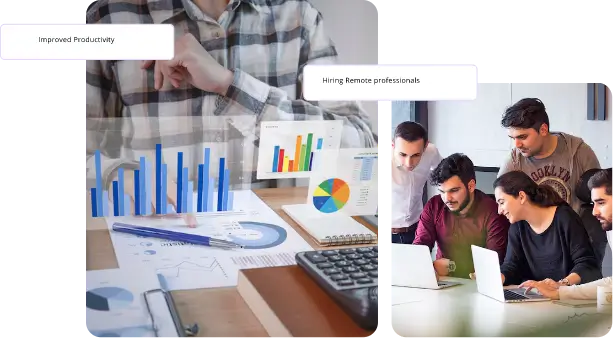Work Session: Meaning, Types, Benefits & How to Improve
A work session is a period designated for an individual or a team to work on specific tasks, solve problems, or brainstorm. A work session is a goal-oriented, time-limited, structured, focused period of time to accomplish a particular purpose. Unlike a regular meeting, where broad discussions, status updates, and other topics can distract from existing work, a work session is there to get it done.
Work sessions can accomplish many tasks, including project or initiative planning, writing or drafting content, performing data analysis or generating reports, or troubleshooting technical issues, among others. With proper planning and enough time, a work session can help cut down distractions that often come from working alone or spending hours in meetings. It aligns efforts to make sure teams are being supported toward business goals. In this post, we will take a look at what a work session is, what its key characteristics are, what types of work sessions exist, the benefits or advantages of using a work session, and how the work session is different from a meeting.
What is a Work Session?
A work session is a time-blocked period where one or more people come together to work on a specific task, problem, or project with a goal and agenda in mind.
Work sessions enhance engagement and productivity. Instead of sitting around and "talking" about the topic in an outward fashion, the participants in the work session are working together to make progress on real work. Work sessions can be done by outplacement offices, a remote team, or even with students.
A work session is helpful because it can provide an opportunity to remove distractions and allow a person or group to focus on one thing at a time. Usually, a work session will be for 1-2 hours with 5-10 breaks to avoid burnout and keep the energy and attention focused. For a successful session, teams typically prepare ahead of time, plan an agenda, roles, and outputs/drops before a work session.
Work sessions can be extremely beneficial when collaboration needs to happen. For example, the content team could plan a work session to write a collaborative blog piece together, or a product team could conduct a work session to create a roadmap. The work session does not matter if it is conducted in real life or online; the outcome is the same, which is to accomplish work.
To review, work sessions create structure in the workday, they enhance performance, they facilitate collaboration, and they permit work to be done without the distractions or unnecessary conversation.
What Are Key Characteristics of Work Sessions?
1. Purposeful
All work sessions have a purpose, whether that is finishing or revising a piece of work, brainstorming new ideas, or a deeper inquiry into a problem. If you have no purpose, you might as well have another meeting.
2. Time-Limited
Work Sessions have a time duration of anywhere from 30 - 120 minutes. The work is time-limited to assist with managing attention span and fatigue.
3. Focused - Without Distraction
During the work session, while other employees may be distracted by phones, emails, and pending tasks, the focus remains entirely on the work at hand.
4. Structured Agenda
Work Sessions do have structure or an agenda; it is not a casual meeting. Meetings may involve lists of things to accomplish, goals to achieve, or even breaks/pauses.
5. Everyone is Active
Everyone who is in the work session must be active. No one should stay quiet or do nothing; everyone must be active in a role or task.
What Are the Different Types of Work Sessions?
1. Individual Work Sessions
Solo focused work. Individual work sessions are when a person is engaging in focused work on their own, sometimes referred to as solo work. A focused task could be writing a report, coding or creating a presentation. These are good for practicing discipline and workflow.
2. Team Work Sessions
In a teamwork session, a face-to-face or virtual group of people is engaging in a focused work session to collaboratively work together on shared work. Sometimes these are cross-functional, for example, marketing and design working together on a campaign.
3. Co-Working Sessions
Co-working sessions are all the rage among remote workers and freelancers. Co-working sessions are when people are working next to one another (physically or virtually), possibly doing completely different work. Co-working sessions can provide accountability and a sense of community in isolation.
4. Brainstorming Sessions
Brainstorming sessions are creative work sessions, focused on idea generation. Team members are encouraged to throw out ideas freely and without judgment, which could lead to innovation.
5. Deep Work Sessions
Deep work sessions are time blocks without distraction for focused, high-concentration work, such as problem solving, research, or design work. Deep work requires working silently and individually, with li
What Are the Benefits of Work Sessions?
1. Enhances Productivity
Work sessions enhance productivity by helping people achieve more in less time. Working in a designated time block, with defined objectives, helps individuals move their project-type tasks along with greater speed and focus.
2. Improves Collaboration
In a teamwork session, people exchange their ideas, unblock issues for each other, and provide each other support. By doing this, people generate a level of trust and improvement in how well the teams interact, developing a higher level of productivity.
3. Clear Accountability
Because the work in the sessions is assigned, it will be easy to keep track of who is doing what, and you can visually account for the completion of tasks everyone has been assigned to within the session itself.
4. Reduces Procrastination
By having a blocked time for work, it encourages individuals to start and complete tasks in the same time block. They won’t have to wait for the next free moment they have, as they have one specifically set aside for work.
5. Increases Morale
When people get work done in their work session, they feel a sense of accomplishment. This sense of reward will lift the whole group’s spirits and keep people motivated each time they are able to complete their tasks.
How Working Sessions Differ from Regular Meetings
Standard meetings typically exist to exchange updates, discuss planned work, or make a decision with a group of people together. Meetings usually have a prescribed agenda and normally contain exchanges of discussion and listening, with participants providing input and moving on. Meetings are about a structured and documented exchange of communication and communication to coordinate and align each other’s and the group’s priorities rather than performing any ‘actual work’ in a meeting.
However, a working session is the opposite: a suggested group activity and process that is much more hands-on and action oriented. The goal of the working session is to work together, in real time, on a specific task or project, as a group: for example, writing a proposal, designing a plan, or solving a problem together. Rather than just talking about what needs to be completed, participants of a working session complete the work as part of the working session.
With the right mindset, a well-defined objective, and a quiet space, you can turn any work session from a meeting into a mini and tangible, and measurable victory. Give it a go and notice how your approach to working with others and your outcomes change.

